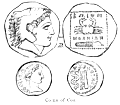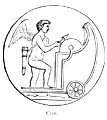Cos
(
Κῶς). An island of the Aegean, one of the Sporades, west
of the promontory of Doris. Its more ancient names were Cea, Staphylus, Nymphaea, and Meropis,
of which the last was the most common. The colonizing of this island must have taken place at
a very early date, since Homer makes mention of it as a populous settlement (
Il. ii. 184). The inhabitants were of Dorian origin, and closely
connected with the Doric colonies on the mainland. Its chief city was Cos, an
 |
|
Coins of Cos.
|
ciently called Astypalaea. Strabo remarks that the city of Cos was not large, but
very populous, and seen to great advantage by those who came thither by sea. Without the walls
was a celebrated temple of Aesculapius, enriched with many admirable works of art, and among
others, two famous paintings of Apelles, the Antigonus and Aphrodité
Anadyomené. The latter painting was so much admired that Augustus removed it to
Rome and consecrated it to Iulius Caesar; and in consideration of the loss thus inflicted on
the Coans, he is said to have remitted a tribute of one hundred talents which had been laid on
them. Besides the great painter just mentioned, Cos could boast of ranking among her sons the
first physician of antiquity, Hippocrates. The soil of the island was very productive,
especially in wine, which vied with those of Chios and Lesbos. It was also
 |
|
Cos.
|
celebrated for its purple dye, and for its manufacture of a species of transparent
silk stuff. See
Coa Vestis.






